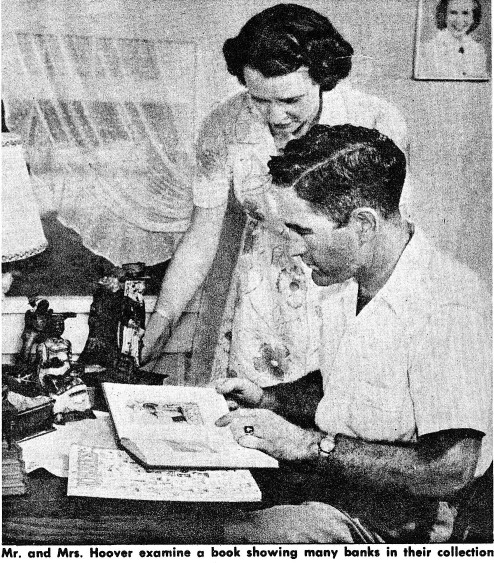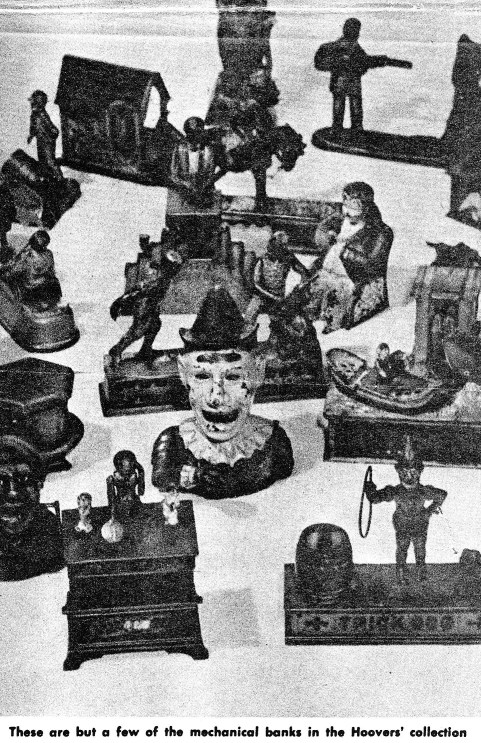|
The Nashville Tennessean Magazine —
November 23, 1947
HOME BANKERS
Walter Hoover’s interest in old cast ironware
eventually led Mrs. Hoover to scrap her glass
collection in favor of her husband’s pursuit

By ED BELL
Collecting old mechanical banks has turned the home of Mr. and Mrs.
Walter King Hoover at Smyrna into a toyland where a
Christmas-like excitement prevails the year round.
With a handful of coins a whole world of little iron men, women,
children, birds and beasts populating their shelves and sideboards may be
set in motion.
Teddy Roosevelt shoots a bear in a hollow tree. An Indian offers the
pipe of peace to Christopher Columbus. A dog takes a coin into a house,
deposits it and reappears. William Tell shoots the apple from his son’s
head. Boss Tweed of old Tammany Hall smugly pockets a coin. A battery of
darkdown baseballers do a perfectly-timed act, the pitcher hurling a penny,
the batter swinging and missing, the penny going into a slot beneath the
catcher. A magician places his hat over a penny on a table, lifts the hat
and the penny is gone. A woman in a rowboat starts to feed Jonah to the
whale, but snatches him back to safety after Mr. J. tosses a penny down the
whale’s throat. A clown stands on his head atop a spinning globe. A mother
eagle feeds her peeping brood.
These and many other diminutive performers are relics of a period in
American history, half a century gone, when Yankee ingenuity exerted itself
to implant the habit of thrift in children by offering them some fun as bait
for saving their pennies.
Hoover is a Smyrna funeral director who some time ago became interested
in collecting old cast ironware — candlesticks, bootjacks, doorstops,
cooking utensils, toy stoves and the like — while repairing an ancient
kettle his wife’s great-great-great grandparents brought to this country
from Switzerland.
One day he bought an assorted batch of such items from a neighborhood
antique dealer and found among them the eagle perched on the edge of her
nest. When a penny was placed in her beak and a lever pressed, she would dip
and feed the young. The bank contained a small bellows which enabled the
eaglets to give out appreciative “peeps.” That find led to his centering on
collecting both mechanical and still banks, a hobby which was to capture the
enthusiasm of his wife, Margaret, and their two children, Denny and Jean.
The new pursuit was so absorbing, in fact, that Mrs. Hoover eventually
abandoned her own collection of glassware.
Although the banks were mainly in vogue in northern parts of this
country from the close of the War Between the States up until 1900, their
origin dates far back in world history. The oldest one known is a mechanical
alms box of glazed green pottery mounted with a small bear who nods
acceptance when a coin is dropped into a slot. Now in New York’s
Metropolitan Museum, the box was a product of the Han Dynasty, perhaps as
long ago as 206 B. C.
In the United States the banks became a great popular art which now
offers as rewarding a field to the student of history as to the collector.
Their designers drew liberally from everyday life around them for subject
matter. Broad humor which would appeal to children was the underlying
characteristic of most of them, but some dealt in satire such as that of
Boss Tweed and another, also in Hoover’s collection, of a gaily-painted
Uncle Sam whose beard waggles as he drops a penny into a carpetbag. Others
were of the commemorative type like Teddy Roosevelt and the bear, probably
designed in anticipation of his campaign for the presidency, and Columbus
and the Indian to memorialize the Columbian exposition. Carnival themes with
dogs jumping through hoops and the antics of clowns were also great
favorites.
Considering the limitations of cast iron, designers showed remarkable
skill and inventiveness in creating little mechanical wonders like darktown
battery with its many small parts, balance, timing and all-around smooth
performance. This one was turned out in the ’Eighties, about the time
baseball began to attract national attention.
Many designers worked on similar themes and subjects accounting for
variants among some of the same types of banks. There are known to be at
least six different “Jolly Niggers” and numerous “Uncle Toms.” Hoover has
No. 2 of the Jonahs, but there is another he hasn’t been able to obtain yet
wherein Jonah is swallowed feet first by the whale. He has two models of the
theme of “Spise the mule,” one with the mule throwing the jockey head first
and another with the mule whirling and kicking a colored boy a somersault.
The inscription on them reads “I always did despise a mule,” hence the
general name for the type.
The banks have not been made since the turn of the century, there are
no reproductions and the patents for the originals have expired, presenting
an ever-narrowing range of operations for the collector.
The trail has led Hoover to semi-monthly rounds of all antique and junk
shops in his immediate vicinity, to perusals of old hardware catalogues and
trips to northern cities to see other collectors, many of whom are also
traders.
His own collection now numbers 55 mechanical banks, several
semi-mechanical (elephants with movable trunks) and 12 still banks. All of
the old banks have well-established prices, he says, their value varying
with their scarcity and mechanical and paint condition.
Now and then he runs across one that somebody has given a fresh coating
of paint, thereby decreasing its value as much as
50 per cent.
Among the rarest in the Hoover collection are a colored mammy feeding a
coin to her child, the magician and the clown on the globe.
Others of varying worth and interest include a lion and monkey, an
artillery-man firing a penny into a fort, two boys playing leap frog, a
monkey and organ grinder, an owl with rotating head, a hoop-jumping dog
(very old), a rooster, frog on lattice, Liberty Bell, Independence Hall
(made prior to the Philadelphia centennial), an Indian shooting a bear and
two performing dogs and a monkey.
Favorite of young Jean is the dog on a turntable taking a penny into
the house. Both children have a great deal of fun with the collection and
are always eager for new additions. Sometimes they act as demonstrators when
visitors come to see the collection.
The banks were never as popular in the impoverished post-war South as
in the North, but nevertheless the Smyrna collector has made some of his
best finds in Middle Tennessee.
One was acquired almost by accident when a casket salesman came to his
place of business one day and Hoover happened to show him the collection.
The salesman remembered having seen one of the gadgets around his own home.
It now belonged to his small daughter, who didn’t care much about it, but
wanted an iron dog.
Hoover gladly traded her a dog doorstop.
That bank was “Paddy and His Pig,” a humorous number placed on the
market at the height of the Irish immigration to these shores. A penny is
deposited on the pig’s snout. When a lever is pressed, the pig kicks the
penny with one foot toward Paddy’s face and the smiling son of the Ould Sod
laps up the currency with a bright red tongue. The pig’s kicking leg was
broken and the bank was sent to a northern collector for repairs.
Paddy is back now occupying a prominent spot in the Hoover home, and
the owners are proud of him even though there is one cloud on their title.
At the time of the trade with the salesman’s child, it was agreed that
if her grandmother, who previously owned the bank, ever heard about the
departure of the family heirloom and raised a ruckus, it would be returned.

|